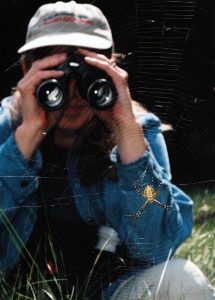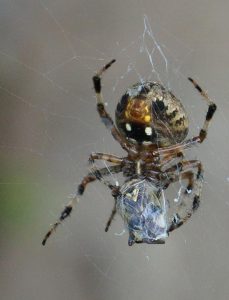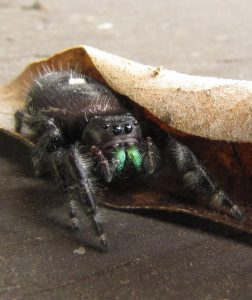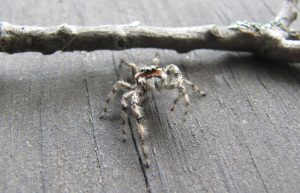
Ask any kindergartener and they will tell you that spiders have eight legs, eight eyes (most do) and two body parts…and they are way cool. Most adults would not agree with the latter part and may shudder and use words like “heebie-jeebies.” Spiders have intrigued humans since ancient times, and were seen as mystical because of their ability to weave intricate webs. Much like the bat, cat, and the owl – spiders (as Halloween symbols and otherwise) are creatures considered to be endowed with supernatural qualities. And, like other creatures of the night, they were associated with witchcraft. However, if we take a few minutes to watch an orb weaver spin a web, or see what the jumping spider on the porch rail is up to, we may learn a few things and realize they are not so spooky after all.

People seem to notice more spiders in their houses and more webs outside this time of year. It could be the display of spider Halloween decorations, but it’s probably due to the fact that the conspicuous orb weaver spiders are mature and more active in the fall. However, spiders can be found year-round in Ohio.
Spiders are a very important part of our ecosystem. Not only do they eat hundreds of insects from our houses, yards and gardens, but they are also a source of food for other organisms. If they decide to live inside your home, and you would prefer they didn’t, they can easily be captured and released outside by employing an empty clear container and a piece of cardboard. Although it is best to leave them where they are, if possible, as they may not survive outside. Also, it was once thought to be bad luck to kill a spider, so keep that in mind the next time you have an uninvited house guest.
What makes a spider?

Spiders are not insects. They belong to a group of animals called arachnids. Scorpions, mites and ticks are also part of the arachnid family. Arachnids are creatures that have two main body parts: cephalothorax and abdomen. The cephalothorax is where the eyes are located, legs are attached and contains some of the spider’s organs. The abdomen contains more organs and is usually the largest part of the spider. Female spiders typically have overall larger body parts than males.
Chelicerae are the most noticeable mouthparts of the spider and are the bright green “fangs” in this photo of the bold jumping spider. Pedipalps (or palps) are on either side of the chelicerae. They are used for tasting, smelling and storage of sperm if the spider is male (large palps usually mean that the spider is male). Both males and females possess this easily identifiable characteristic but they can range in color from green to blue to even purple.
Jumping spiders
A particularly interesting group of spider is the jumping spider. There are 47 species of this group residing north of Mexico. They appear quite charismatic, mostly because of their furry appearance and forward-facing, observant eyes that seem to be following your every move. Jumpers face their opponents, on occasion waving their front legs and jumping at the antagonist. A few have launched themselves onto my camera lens! They are classified as wandering spiders but prefer to capture their prey by stalking it, not creating a prey-catching web as many other spiders do. Jumping spiders do make silk as a safety line and to spin their egg sacs.
The bold jumping spider is very noticeable because of it’s size and markings. Although the spider appears to look like a monster in the photograph above, it can easily fit on a dime. Males and females all have a variety of white bands, spots and dots. The younger spiders even have an orange dot on their abdomen.

Male tan jumping spiders have what appears to be an outrageous orange “moustache.” The abdomen is elongated and has beautiful undulating patterns of tan, gray and black. Tan jumpers are commonly found on vertical sites such as wooden fences and on the sides of houses and buildings. They hunt various flies and a scientist observed one eating an earthworm. This species actually overwinters as a juvenile spider, seeking shelter under tree bark. (By Alli Shaw, Naturalist at Sharon Woods Metro Park)
